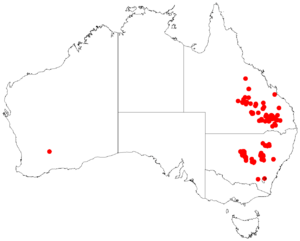Gaping mint-bush facts for kids
Quick facts for kids Gaping mint-bush |
|
|---|---|
| Scientific classification | |
| Genus: |
Prostanthera
|
| Species: |
ringens
|
 |
|
| Occurrence data from AVH | |
| Synonyms | |
|
|
The Gaping mint-bush (scientific name: Prostanthera ringens) is a beautiful flowering plant. It belongs to the mint family, called Lamiaceae. This plant is special because it only grows naturally in eastern Australia. This means it is an endemic species.
It's a bushy shrub. Its branches have four sides and are a bit hairy. They also have many tiny glands. The leaves look like eggs or are oblong. The flowers are pale blue, greenish, or yellow. They grow one by one where the leaves meet the stem.
What Does It Look Like?
The Gaping mint-bush is a bushy shrub. It usually grows up to 2 m (6 ft 7 in) (about 6.5 feet) tall. Its branches have four sides and are covered in fine hairs. They also have many small glands, which are like tiny bumps.
The leaves are shaped like eggs or are oblong. They are about 6–15 mm (0.24–0.59 in) long and 2–6 mm (0.079–0.236 in) wide. Each leaf sits on a small stalk called a petiole, which is up to 3 mm (0.12 in) long.
The flowers grow one by one where the leaves join the stem. At the base of each flower, there are tiny leaf-like parts called bracteoles, about 1 mm (0.039 in) long.
The outer parts of the flower, called sepals, are 6–8 mm (0.24–0.31 in) long. They form a tube about 5 mm (0.20 in) long with two small tips. The colorful petals are 14–23 mm (0.55–0.91 in) long. They can be pale blue, greenish, or yellow. These petals also form a tube, which is about 10 mm (0.39 in) long.
How Was It Named?
The Gaping mint-bush was first officially described in 1848. A botanist named George Bentham gave it its scientific name, Prostanthera ringens.
He wrote about it in a book called Journal of an Expedition into the Interior of Australia. This book was written by Thomas Mitchell, an explorer.
Where Does It Grow?
The Gaping mint-bush grows in eastern Australia. You can find it on rocky sandstone ridges and stony hills. It also grows in forests.
It is found on the western slopes and plains of New South Wales. This includes areas north of Mendooran. It also grows in eastern central Queensland. This includes regions like the Darling Downs, Maranoa, and Mitchell districts.
Is It Protected?
The Gaping mint-bush is not considered to be in danger. In Queensland, it is classified as being of "least concern." This means there are plenty of these plants in the wild.
This classification is under the Queensland Government's Nature Conservation Act 1992.

